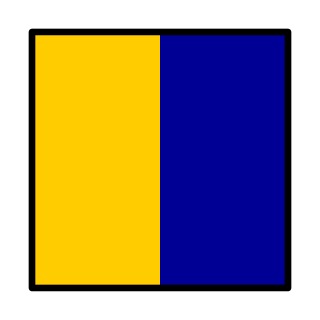
The International Telecommunication Union (ITU) is a specialized agency of the United Nations responsible for many matters related to information and communication technologies. It was established on 17 May 1865 as the International Telegraph Union, significantly predating the UN and making it the oldest UN agency. Doreen Bogdan-Martin is the Secretary-General of ITU, the first woman to serve as its head.

Morse code is a telecommunications method which encodes text characters as standardized sequences of two different signal durations, called dots and dashes, or dits and dahs. Morse code is named after Samuel Morse, one of the early developers of the system adopted for electrical telegraphy.

Wireless telegraphy or radiotelegraphy is the transmission of text messages by radio waves, analogous to electrical telegraphy using cables. Before about 1910, the term wireless telegraphy was also used for other experimental technologies for transmitting telegraph signals without wires. In radiotelegraphy, information is transmitted by pulses of radio waves of two different lengths called "dots" and "dashes", which spell out text messages, usually in Morse code. In a manual system, the sending operator taps on a switch called a telegraph key which turns the transmitter on and off, producing the pulses of radio waves. At the receiver the pulses are audible in the receiver's speaker as beeps, which are translated back to text by an operator who knows Morse code.
The International Radiotelephony Spelling Alphabet or simply the Radiotelephony Spelling Alphabet, commonly known as the NATO phonetic alphabet, is the most widely used set of clear-code words for communicating the letters of the Roman alphabet. Technically a radiotelephonic spelling alphabet, it goes by various names, including NATO spelling alphabet, ICAO phonetic alphabet, and ICAO spelling alphabet. The ITU phonetic alphabet and figure code is a rarely used variant that differs in the code words for digits.
The Q-code is a standardised collection of three-letter codes that each start with the letter "Q". It is an operating signal initially developed for commercial radiotelegraph communication and later adopted by other radio services, especially amateur radio. To distinguish the use of a Q-code transmitted as a question from the same Q-code transmitted as a statement, operators either prefixed it with the military network question marker "INT" or suffixed it with the standard Morse question mark UD.
The ITU Radio Regulations (RR) is a basic document of the International Telecommunication Union (ITU) that regulates on law of nations scale radiocommunication services and the utilisation of radio frequencies. It is the supplementation to the ITU Constitution and Convention and in line with the ITU International Telecommunication Regulations (ITR). The ITU RR comprise and regulate the part of the allocated electromagnetic spectrum from 9 kHz to 300 GHz.

SOS is a Morse code distress signal, used internationally, originally established for maritime use. In formal notation SOS is written with an overscore line, to indicate that the Morse code equivalents for the individual letters of "SOS" are transmitted as an unbroken sequence of three dots / three dashes / three dots, with no spaces between the letters. In International Morse Code three dots form the letter "S" and three dashes make the letter "O", so "S O S" became a common way to remember the order of the dots and dashes. IWB, VZE, 3B, and V7 form equivalent sequences, but traditionally SOS is the easiest to remember.
CQD is one of the first distress signals adopted for radio use. On 7 January 1904 the Marconi International Marine Communication Company issued "Circular 57", which specified that, for the company's installations, beginning 1 February 1904 "the call to be given by ships in distress or in any way requiring assistance shall be 'C Q D' ".
CQ is a station code used by wireless operators derived from long established telegraphic practice on undersea cables and landlines, particularly used by those communicating in Morse code,, but also by voice operators, to make a general call. Transmitting the letters CQ on a particular radio frequency means that the transmission is a broadcast or "General Call" to anyone listening, and when the operator sends "K" or says "Go Ahead" it is an invitation for any licensed radio station listening on that frequency to respond. Its use on radio matched the existing use on Morse landline telegraphy and dates from the earliest wireless stations. It was widely used in point-to-point diplomatic and press services, maritime, aviation, and police services until those services eliminated Morse radiotelegraphy. It is still widely used in amateur radio which still has active use of Morse radiotelegraphy.
From early in the 20th century, the radio frequency of 500 kilohertz (500 kHz) was an international calling and distress frequency for Morse code maritime communication. For much of its early history, this frequency was referred to by its equivalent wavelength, 600 meters, or, using the earlier frequency unit name, 500 kilocycles or 500 kc.

The 6-meter band is the lowest portion of the very high frequency (VHF) radio spectrum internationally allocated to amateur radio use. The term refers to the average signal wavelength of 6 meters.
The Radio Act of 1912, formally, known as "An Act to Regulate Radio Communication", is a United States federal law which was the country's first legislation to require licenses for radio stations. It was enacted before the introduction of broadcasting to the general public, and was eventually found to contain insufficient authority to effectively control this new service, so the Act was replaced and the government's regulatory powers increased by the passage of the Radio Act of 1927.

The International Code of Signals (INTERCO) is an international system of signals and codes for use by vessels to communicate important messages regarding safety of navigation and related matters. Signals can be sent by flaghoist, signal lamp ("blinker"), flag semaphore, radiotelegraphy, and radiotelephony. The International Code is the most recent evolution of a wide variety of maritime flag signalling systems.

Procedural signs or prosigns are shorthand signals used in Morse code telegraphy, for the purpose of simplifying and standardizing procedural protocols for landline and radio communication. The procedural signs are distinct from conventional Morse code abbreviations, which consist mainly of brevity codes that convey messages to other parties with greater speed and accuracy. However, some codes are used both as prosigns and as single letters or punctuation marks, and for those, the distinction between a prosign and abbreviation is ambiguous, even in context.
A spelling alphabet is a set of words used to represent the letters of an alphabet in oral communication, especially over a two-way radio or telephone. The words chosen to represent the letters sound sufficiently different from each other to clearly differentiate them. This avoids any confusion that could easily otherwise result from the names of letters that sound similar, except for some small difference easily missed or easily degraded by the imperfect sound quality of the apparatus. For example, in the Latin alphabet, the letters B, P, and D sound similar and could easily be confused, but the words "bravo", "papa" and "delta" sound completely different, making confusion unlikely.
The Wireless Ship Act of 1910, formally titled "An Act to require apparatus and operators for radio-communication on certain ocean steamers" and also known as the "Radio Ship Act of 1910" and the "Radio Act of 1910", was the first federal legislation regulating radio communication in the United States. It required certain ocean-going vessels exiting U.S. ports to carry radio equipment, and although it did not require stations or operators to be licensed, it did require certification that operators and radio equipment met minimum standards.
A radiogram is a formal written message transmitted by radio. Also known as a radio telegram or radio telegraphic message, radiograms use a standardized message format, form and radiotelephone and/or radiotelegraph transmission procedures. These procedures typically provide a means of transmitting the content of the messages without including the names of the various headers and message sections, so as to minimize the time needed to transmit messages over limited and/or congested radio channels. Various formats have been used historically by maritime radio services, military organizations, and Amateur Radio organizations.
Call signs in Canada are official identifiers issued to the country's radio and television stations. Assignments for broadcasting stations are made by the Canadian Radio-television and Telecommunications Commission (CRTC), while amateur stations receive their call signs from Innovation, Science and Economic Development Canada. Conventional radio and television broadcasting stations assignments are generally three, four or five letters long and almost exclusively use "C" call signs; with a few exceptions noted below, the "V" calls are restricted to specialized uses such as amateur radio.
The Preliminary Conference on Wireless Telegraphy, held in Berlin, Germany, in August 1903, reviewed radio communication issues, in preparation for the first International Radiotelegraph Convention held three years later. This was the first multinational gathering for discussing the development of worldwide radio standards.
The first International Radiotelegraph Convention was held in Berlin, Germany, in 1906. It reviewed radio communication issues, and was the first major convention to set international standards for ship-to-shore communication. One notable provision was the adoption of Germany's "SOS" distress signal as an international standard.







